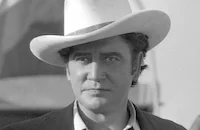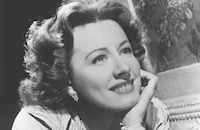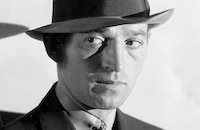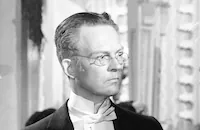Cimarron

Brief Synopsis
Cast & Crew
Wesley Ruggles
Richard Dix
Irene Dunne
Estelle Taylor
Nance O'neil
William Collier Jr.
Film Details
Technical Specs

Synopsis
Inspired by his adventures during the 1889 Oklahoma land rush, Yancey Cravat, a freewheeling lawyer and newspaper editor, convinces his Eastern-bred wife Sabra to leave her stuffy Wichita family and join him in the West. Although Sabra finds Osage, the Oklahoma "boomer town" that Yancey has chosen to start his newspaper, rough and squalid, she settles there with him and, with help from their young black servant Isaiah, undertakes to bring up her son "Cim." Soon after his arrival, Yancey confronts local outlaw and bully Lon Yountis with the murder of the newspaper's previous editor. During an "all-faiths church meeting," which Yancey has been asked to conduct at the town gambling hall, Yancey threatens to identify the editor's killer and is shot at by Lon. In self-defense, Yancey kills Lon, then dismisses his "flock," which includes Dixie Lee, a maligned prostitute whom Yancey had befriended during the land rush. A year later, after the birth of the Cravats' daughter Donna, Osage is besieged by an outlaw gang led by The Kid, an old cowboy friend of Yancey's. Although Yancey kills The Kid during a fierce gun battle, which also claims the life of the loyal Isaiah, he refuses to collect any reward for his deed and bemoans The Kid's downfall. In 1893, a new "Cherokee Strip" land rush is announced, and Yancey, who has never stayed in one place for more than five years, deserts the much-settled Sabra to participate in it. Helped and supported by expert printer Jesse Rickey and department store owner Sol Levy, Sabra, who knows nothing of Yancey's whereabouts, takes over the newspaper. Five years later, dressed in a "Rough Riders" uniform, Yancey returns to Osage just as Sabra and a group of "decent women" are about to try Dixie Lee as a "public nuisance." Yancey successfully defends the misunderstood Dixie in court, then convinces his less tolerant wife of Dixie's essential goodness. After Oklahoma obtains statehood in 1907 and the oil boom has brought prosperity to some of the Osage Indians, Yancey, who has been approached to participate in a political scheme to trick the Indians out of their wealth, writes a provocative editorial favoring citizenship for all American Indians. Despite the heated objections of Sabra, who has always loathed the Indians and who is repulsed by her son's romantic involvement with an Indian chief's daughter, Yancey publishes the editorial and then disappears. Many years later, after the fortieth anniversary of the newspaper's founding, Sabra is elected as Oklahoma's first Congresswoman. During a luncheon in her honor, a more tolerant Sabra speaks fondly of her Indian daughter-in-law and her long-lost husband. Just before she is to dedicate a statue honoring the Oklahoma pioneers, Sabra hears that a tramp called "Old Yance" has risked his own life to save many oil drillers from a deadly explosion. Sabra rushes to the accident site in time to embrace Yancey before his death, then discovers that the statue has been sculpted in his image.

Director

Wesley Ruggles
Cast

Richard Dix

Irene Dunne
Estelle Taylor

Nance O'neil
William Collier Jr.

Rosco Ates

George E. Stone
Stanley Fields

Robert Mcwade

Edna May Oliver
Nancy Dover
Eugene Jackson
Frank Darien
Dolores Brown
Gloria Vonic
Otto Hoffman
William Orlamond
Frank Beal

Helen Parrish

Donald Dilloway
Junior Johnson

Douglas Scott
Reginald Scott
Lois Jane Campbell
Ann Lee
Tyrone Brereton
Lillian Lane
Henry Roquemore
Nell Craig
Robert Mckenzie
William Janney
George Lollier
Billy Elmer
Ethan Laidlaw
Frank Lackteen
Mildred Frizelle
Jack Leonard
Walter Lewis
Marion Mirsch
Lillian West
Max Barwyn
Carl Stockdale
Heinie Conklin
Barney Furey
Tim Lonergan
Helen Trask
Leo Willis
Ford West
Harry Holden
Alice Adair
Kay Deslys
Dorothy Simms
Dorothy Ray
Crew
E. F. Adams
Willard Barth
Neal Beckner
Guy Bennett
Otto Benninger
Fred Bentley
Joseph Biroc
O. H. Borradaile
H. Lyman Broening
Frank Burgess
Bob Burns
Paul Cable
Emilio Calori
Roy Clark
Rex Cole
Ken Cooper
Lee Cooper
Doran Cox
Edward Cronjager
Rex Curtis
Hyatt Daab
Dean Dailey
James Daly
Louis Deangelis
Bob Degrasse
George Diskant
Linwood Dunn
Elmer Dyer
Breezy Eason
Mack Elliott
Bob Erickson
Howard Estabrook
Ed Garvin
Pliny Goodfriend
Jack Grout
"shorty" Hall
William Hamilton
Neal Harbarger
Ted Hayes
Bill Heckler
Harold Hendee
Edward Henderson
Fred Hendrickson
Fred Hendrickson
Russell Hoover
Newton Hopcraft
Harry Jackson
Pete Janet
Charles Johnson
William Johnson
Buff Jones
Gordon Jones
Maurice Kains
Harry Kauffman
Ed Kearns
James King
Lloyd Knechtel
Ed Kull
Jack Landrigan
F. D. Langton
Joe Lashelle
William Lebaron
Fred Mayer
Earl Metz
Nick Musuraca
Joe Novak
Robert Pittack
Bud Pope
Clem Portman
Hank Potts
Edward Pyle
Frank Redman
Max Rée
Max Rée
Walt Robbins
Wesley Ruggles
Louis Sarecky
Louis Sarecky
William J. Schuck
Les Shorr
Al Smalley
Whitey Sovern
Ralph Spotts
Dewey Starkey
Judd Steven
John Thompson
Rod Tolmie
Ed Ullman
Sidney Ullman
Harry Underwood
Joe Walters
Harold Wellman
Ern Westmore
Ben White
Colonel Whitehorse
Harry Wild
Rex Wimpy
Lothrop Worth

Photo Collections
Videos
Movie Clip



Hosted Intro
Film Details
Technical Specs

Award Wins
Best Art Direction
Best Picture
Best Writing, Screenplay
Award Nominations
Best Actor
Best Actress
Best Cinematography
Best Director
Articles
Cimarron (1930)
It helps if one can view Cimarron (1931) in the context of its era. It had, at the time, the largest budget for an RKO picture - a whopping $1,433,000 (remember, filming began in 1930, the era of the Great Depression) and the production values for the day were tremendous. For example, producer William LeBaron hired action expert B. Reeves Eason to engineer the Oklahoma run sequence. Eason had conducted the terrific chariot race for Ben-Hur (1925) and the scope of material he needed to achieve this sequence was quite something for its time: over 5000 extras, 47 cameramen, an army of assorted technicians and livestock covering more than 40 acres!
The casting of Richard Dix in the part of Yancey was a crucial factor in the film's success. Dix was a popular and unmistakably American actor of the late 1920's and RKO reportedly purchased the rights to the novel specifically for Dix, whom they had under contract. Dix's strong rugged features, determined yet kindly, made him the perfect pioneer archetype. The choosing of Irene Dunne as Sabra was much more intriguing. Broadway star Fay Bainter was considered for the lead role, but fell out of favor with the producer, William LeBaron. Irene Dunne's determination to get the role is best exemplified by a cheeky maneuver she pulled one Saturday afternoon. She asked make-up artist Ernest Westmore, and cameraman Ernest Bracken to devote that day to helping her make a series of photographs that would age her convincingly from 16 to 56. The photos were placed on LeBaron's desk the next morning with a note from Westmore, "This is Irene Dunne, the girl who should play the lead in Cimarron." This, coupled with Dix's insistence that Dunne be his co-star (Dix had a reputation for helping relative unknowns get parts in his pictures), prompted LeBaron to order a screen test of Dunne and she got the part.
It's true that the film has dated somewhat. Once Dunne mentioned it as one of her favorite films but later deemed Cimarron "rather hammy" after a 1975 viewing. And it severely lacks political correctness. One character's stutter is exploited for comic relief and the black servant boy Isaiah (Eugene Jackson) and the Jewish tailor Levy are painful stereotypes. However, Cimarron does champion some progressive attitudes. Sabra is clearly a woman of independent means (she is a newly elected congresswoman at the movie's close), and her son Cimarron is married to an Indian princess (a first sign of miscegenation, during the pre-code era) and eventually the theme of racial and religious tolerance does comes across.
The film premiered at the Globe Theater in New York on January 26, 1931 and received unanimous praise by all the major publications including the New York Times and Variety and received Oscar wins for Best Picture, Story (Howard Estabrook) and Art Direction (Max Ree). It also proved that RKO, then considered a small studio, was capable of big budget epics and moved them into the big leagues, where they remained for a long time.
Producer: William LeBaron, Wesley Ruggles
Director: Wesley Ruggles
Screenplay: Edna Ferber (novel), Howard Estabrook
Cinematography: Edward Cronjager
Costume Design: Max Ree
Film Editing: William Hamilton
Original Music: Max Steiner
Cast: Richard Dix (Yancey Cravat), Irene Dunne (Sabra Cravat), Estelle Taylor (Dixie Lee), Nance O'Neil (Felice Venable), William Collier Jr. (The Kid)
BW-124m. Closed captioning.
by Michael Toole

Cimarron (1930)
Cimarron (1931) - Cimarron - The Oscar® winning Best Picture of 1931 on DVD
Defeated in the land rush, Yancey returns to Wichita to the home of his inlaws where his wife is staying in his absence. The family is appalled to learn that Yancey still intends to move to Oklahoma, unswayed by his firm believe that Oklahoma is where all the growth and excitement in the country is going to happen. Yancey and his wife Sabra (Irene Dunne) put together two wagon loads of the belongings and head west, along with their baby boy Cim, and Isaiah, the African American boy who helps around the house. Their destination is Osage, and when they get there it turns out to be a boom town in more ways than one: the population of Osage soared to 10,000 in just six weeks. The Main Street is mud and is swarming with pedestrians and people who appear to be in a constant state of celebration. Sabra is horrified by her first glimpse of the town Yancey intends to make their home, and flat-out refuses to raise their child there. But Yancey placates her with the promise that it will calm down, and that it'll be the perfect place to re-start-up his newspaper, the Oklahoma Wigwam.
Once they have established themselves and started the paper, Yancey proves himself something of a jack-of-all-trades. He volunteers to preach in the town's makeshift church, and makes the service particularly memorable when he shoots an outlaw in the middle of the sermon. He single-handedly engages in more than one shootout with gangs of outlaws, picking them off one by one until they're all dead. And at the same time he and Sabra manage to get out a daily paper – and have a second child, this one a daughter.
After four years in Osage, Yancey's wanderlust kicks in again when the president signs a new order opening the Cherokee strip to settlers. Despite Sabra's angry protests about not wanting to pull up stakes and wanting to stay in the home she's come to love, Yancey decides to at least take part in this land rush. So he sets out again, and long after the run is over he still hasn't returned. Unable to resist a challenge, he gets involved in fighting in the Spanish-American war. In his absence, knowing his nature Sabra never once ceases to believe that he's still alive, but his absence still stings. It isn't until five years have passed that he returns home. He's welcomed warmly, if not exactly with open arms, but soon they have re-established their relationship.
Several years pass before Yancey gives into his need to travel. In his absence this time, Sabra achieves local prominence and comes to national attention for her editorials on the political situation. Though she is getting old, her sharp mind and understanding of politics leads her to become a congresswoman, which seems to delight everyone including men. She is touring an oil field when she very unexpectedly is reunited with Yancey that turns tragic.
The first Western to win the Oscar®, Cimarron is a sprawling, episodic epic with a strong script (based on the novel by Edna Ferber), an equally strong story, and some truly wonderful visuals. But the main reason it works is because it tells it's sprawling story by focusing on one couple. The more I see of Irene Dunne, the more I think she could do no wrong. She gives a first-class performance, infusing the role with a range of emotions (and a sense of weariness that would be impossible to duplicate). Richard Dix as Yancey gives a more one-note performance, which seems no less than what the role calls for: he is slightly bombastic but despite his expertise in seemingly everything, Dix manages to play Yancey without a hint of ego. Dix's role is difficult, since the fact that he leaves he wife for years at a time does not make him particularly endearing. But again, Dix is capable of playing him as enough of a lovable rogue that he doesn't lose audience sympathy.
Dunn and Dix are are given fine support by Edna May Oliver as Mrs. Tracy Wyatt, a widow who befriends the Cravats when the move into town.
The vintage of the film (1931) pretty much ensures that the source material will not be in great condition, and it's not: there are a lot of scratched, general wear, and some damage. But the film is still eminently watchable. The audio is also showing signs of deterioration. The disc includes the vintage musical short "The Devil's Cabaret," and the classic cartoon "Red Headed Baby."
For more information about Cimarron, visit Warner Video. To order Cimarron, go to TCM Shopping.
by Fred Hunter
Cimarron (1931) - Cimarron - The Oscar® winning Best Picture of 1931 on DVD
Quotes
Louie Heffner, as coroner do your official duty and remove the body.- Yancy Cravat
Okay, Yancy. It was self-defense and justifiable homicide. This town needs a Boot Hill and I'll start it with this burial.- Louie Heffner
Fellow citizens! Under the circumstances, we will forego the sermon and conclude this service with a brief word of prayer.- Yancy Cravat
Trivia
Yancey Cravat, the character played by Richard Dix, was based on the real-life lawyer and gunfighter Temple Houston -- the son of Sam Houston, whom Dix played in Man of Conquest (1939).
One of the extras was Nino Cochise, the actual grandson of the great Chiricahua chief Cochise. He and his good friend Bill Russell were in this movie as well as several others.
A then-record $125,000 was paid for the film rights to the novel.
The land rush scene took a week to film, using 5,000 extras, 28 cameramen, 6 still photographers and 27 camera assistants.
This was the first Western to win an Oscar.
Notes
The following statement is included in the film's opening credits: "For certain descriptive passages in Cimarron Miss Ferber makes acknowledgement to Hands Up by Fred E. Sutton and A. B. MacDonald." Sutton and MacDonald's novel was published in New York in 1927. According to an October 1932 Los Angeles Examiner news item, the studio bid $125,000 for the rights to Ferber's novel. That amount, which was also paid by Universal for the rights to Strictly Dishonorable, also produced in 1931 (see AFI Catalog of Feature Films, 1931-40; F3.4369), was the highest ever paid by motion picture companies for rights to literary properties, according to the news item. The picture's famous land rush scene, which required a week to film, was shot at Jasmin Quinn Ranch near Bakersfield, CA, according to studio production files. Publicity for the picture notes that 5,000 extras participated in that scene and forty-seven cameras were used to shoot it. An International Photographer articles states that the land rush scene was shot by twenty-eight cameramen, six stillmen and twenty-seven assistants, to make a total camera crew of sixty-one, one of the largest group of cameramen ever assembled for one sequence. According to publicity, the Native Americans who appeared in the film were "made up white to appear coppery on the screen." Production files indicate that the film cost $1,434,800 to produce and went over budget by $354,114. Modern sources state that the picture lost $565,000 at the box office in its initial release. Some of this loss was recouped in a 1935 re-issue. The film had its premiere at the Globe Theater in New York, where the top ticket price was $2.00. Cimarron won Academy Awards for Best Picture, Best Adaptation and Best Art Direction. It was nominated for Best Direction, Best Actor (Richard Dix), Best Actress (Irene Dunne) and Best Cinematography. Film Daily Year Book included the film in its "one of the year's ten best pictures" list.
Modern sources add the following cast credits: Clara Hunt (Indian girl), Bob Kortman (Killer) and Dennis O'Keefe (who at that time was known as Bud Flanagan). William Janney is identified in the role of a "worker" by modern sources. In 1960 Anthony Mann directed Glenn Ford and Maria Schell in an M-G-M version of Ferber's novel (see below).

Miscellaneous Notes
reels 13
Released in United States Winter January 1, 1930
Released in United States Winter January 1, 1930














